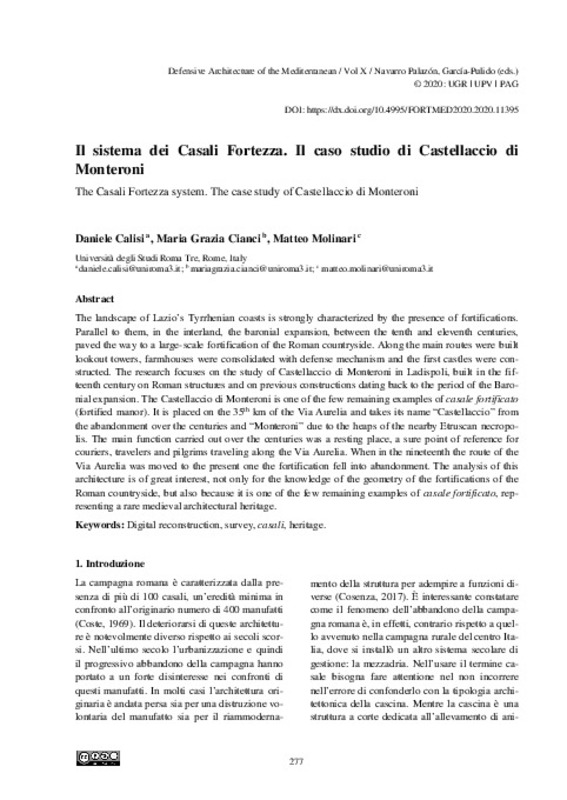JavaScript is disabled for your browser. Some features of this site may not work without it.
Buscar en RiuNet
Listar
Mi cuenta
Estadísticas
Ayuda RiuNet
Admin. UPV
Il sistema dei Casali Fortezza. Il caso studio di Castellaccio di Monteroni
Mostrar el registro sencillo del ítem
Ficheros en el ítem
| dc.contributor.author | Calisi, Daniele
|
es_ES |
| dc.contributor.author | Cianci, Maria Grazia
|
es_ES |
| dc.contributor.author | Molinari, Matteo
|
es_ES |
| dc.coverage.spatial | east=12.1261294; north=41.9400778; name=Via dell'Acquedotto Statua, 2, 00055 Ladispoli RM, Itàlia | es_ES |
| dc.date.accessioned | 2020-07-06T09:02:31Z | |
| dc.date.available | 2020-07-06T09:02:31Z | |
| dc.date.issued | 2020-05-15 | |
| dc.identifier.isbn | 9788490488560 | |
| dc.identifier.uri | http://hdl.handle.net/10251/147481 | |
| dc.description.abstract | [EN] The landscape of Lazio’s Tyrrhenian coasts is strongly characterized by the presence of fortifications. Parallel to them, in the interland, the baronial expansion, between the tenth and eleventh centuries, paved the way to a large-scale fortification of the Roman countryside. Along the main routes were built lookout towers, farmhouses were consolidated with defense mechanism and the first castles were constructed. The research focuses on the study of Castellaccio di Monteroni in Ladispoli, built in the fifteenth century on Roman structures and on previous constructions dating back to the period of the Baronial expansion. The Castellaccio di Monteroni is one of the few remaining examples of casale fortificato (fortified manor). It is placed on the 35th km of the Via Aurelia and takes its name “Castellaccio” from the abandonment over the centuries and “Monteroni” due to the heaps of the nearby Etruscan necropolis. The main function carried out over the centuries was a resting place, a sure point of reference for couriers, travelers and pilgrims traveling along the Via Aurelia. When in the nineteenth the route of the Via Aurelia was moved to the present one the fortification fell into abandonment. The analysis of this architecture is of great interest, not only for the knowledge of the geometry of the fortifications of the Roman countryside, but also because it is one of the few remaining examples of casale fortificato, representing a rare medieval architectural heritage. | es_ES |
| dc.language | Italiano | es_ES |
| dc.publisher | Editorial Universitat Politècnica de València | es_ES |
| dc.rights | Reconocimiento - No comercial - Sin obra derivada (by-nc-nd) | es_ES |
| dc.subject | Fortifications | es_ES |
| dc.subject | Mediterranean | es_ES |
| dc.subject | Modern age | es_ES |
| dc.subject | Built Heritage | es_ES |
| dc.subject | Digital Reconstruction | es_ES |
| dc.subject | Survey | es_ES |
| dc.subject | Casali | es_ES |
| dc.subject | Heritage | es_ES |
| dc.title | Il sistema dei Casali Fortezza. Il caso studio di Castellaccio di Monteroni | es_ES |
| dc.title.alternative | The Casali Fortezza system. The case study of Castellaccio di Monteroni | es_ES |
| dc.type | Capítulo de libro | es_ES |
| dc.type | Comunicación en congreso | es_ES |
| dc.identifier.doi | 10.4995/FORTMED2020.2020.11395 | |
| dc.rights.accessRights | Abierto | es_ES |
| dc.description.bibliographicCitation | Calisi, D.; Cianci, MG.; Molinari, M. (2020). Il sistema dei Casali Fortezza. Il caso studio di Castellaccio di Monteroni. Editorial Universitat Politècnica de València. 277-284. https://doi.org/10.4995/FORTMED2020.2020.11395 | es_ES |
| dc.description.accrualMethod | OCS | es_ES |
| dc.relation.conferencename | FORTMED2020 - Defensive Architecture of the Mediterranean | es_ES |
| dc.relation.conferencedate | Octubre 01-03,2020 | es_ES |
| dc.relation.conferenceplace | Granada, Spain | es_ES |
| dc.relation.publisherversion | http://ocs.editorial.upv.es/index.php/FORTMED/FORTMED2020/paper/view/11395 | es_ES |
| dc.description.upvformatpinicio | 277 | es_ES |
| dc.description.upvformatpfin | 284 | es_ES |
| dc.type.version | info:eu-repo/semantics/publishedVersion | es_ES |
| dc.relation.pasarela | OCS\11395 | es_ES |








